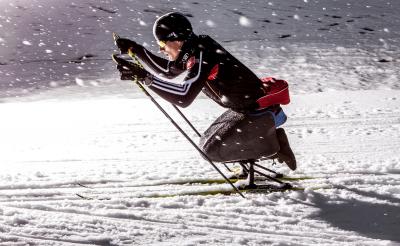Feb 7 2013
The athlete speeds along the cross-country ski run. Things are looking good for him. Up until now he has been in line for a new personal best time. However, whether or not he finishes first is often decided by just a few seconds. With such tight timings everything must be right, including the conditions on the cross-country ski run, the condition of the athlete on the day and the optimally adapted custom-fit skis.
 Professional athlete and wheelchair user Martin Fleig trains with a ski sledge. (Credit: Ruben Elstner, MikroTribologie Centrum µTC)
Professional athlete and wheelchair user Martin Fleig trains with a ski sledge. (Credit: Ruben Elstner, MikroTribologie Centrum µTC)
In contrast to Olympic skiing stars who are wooed by sponsors, up until now this has not been a matter of course for elite athletes with disabilities. The development of sports equipment especially adapted to the requirements of physically challenged competitive athletes is still in its infancy. This is partly due to the relative lack of interest on the part of sponsors and partly because many paralympic disciplines are still fairy new.
However, this is to change, at the latest in time for the Winter Paralympics 2014 in Sochi. Researchers at the Fraunhofer Institute for Mechanics of Materials IWM are working with research and industry partners to create optimized skis sledges for handicapped cross-country and biathlon skiers. "Our aim is to construct optimized ski sledges for all competitors based on bio-mechanical relationships", says Prof. Matthias Scherge, head of the tribology business area at IWM and coordinator of the project consortium. The challenge in relation to this is that the degree and nature of the physical disability is different for each athlete – and the athlete can only optimally utilize his strength in a very specific seated position. "For this reason, every athlete essentially requires a unique solution", explains Scherge.
Detailed design through three-dimensional scanning
The athlete's customized seat shape is determined in a simulation model. For this the athlete sits in a cross-country ski sledge and supports himself with ski poles. Partners from the Institute of Sport and Sport Science at the University of Freiburg, Germany attach markers to various parts of the athlete's body to map the sequence of movements. Sensors in the poles measure the transmission of energy while the athlete pushes off. The results are fed directly into a simulation program which then creates a bio-mechanical model. This model then allows the rough geometry of the seat to be derived. For the detailed design, the athlete is scanned in three dimensions under exertion. An additional simulation enables the experts to analyze areas where excess weight can be saved without affecting the stability of the material. This optimized lightweight prototype is then manufactured in a generative manufacturing process – in other words, directly from the design data – which means the cost of the sports equipment is kept within reasonable limits.
Normal racing skis can be attached to the sledge. "However, the skis move differently under the sledge than they would do during normal skiing. They are only being moved in a straight line", adds Scherge. "This must be taken into consideration during the grinding process". For this reason, the IWM researchers have developed special ski grindings for use under ski sledges in collaboration with Montana. In this case, at the end it is still necessary to carry out a fine tuning process which is specially adapted to the individual athlete. For example, the weight of the athlete affects the surface in contact with the snow. In terms of ski coatings, Prof. Scherge and his team have many years of experience in international elite sports at their disposal. Coatings developed by IWM ensure that the skis are able to glide through the snow with minimal friction.
The project planners intend to use the time until 2014 to optimize their developments. In doing so, the consortium is open to additional co-operation with interested parties. Prof. Scherge also hopes that the paralympics will also create an impetus in terms of recreational sports. "It would be nice if the paralympics could provide disabled people with new sport-related perspectives when it becomes clear that everything is possible with the right technical support."